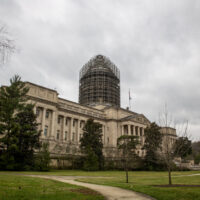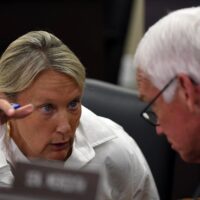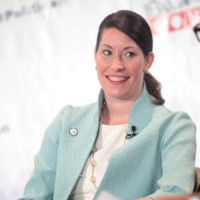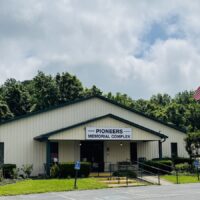The state’s top doctor said Monday that from a medical standpoint, Kentucky has done “a pretty good job” dealing with coronavirus, but Gov. Andy Beshear said the state would be doing better if President Trump set a better example by wearing a facial covering.

Asked to grade Trump’s efforts against the virus, Beshear declined, except to say, “I have mentioned that we really need the president to wear a mask, that if the president would routinely wear a mask, then there’s probably a couple hundred thousand Kentuckians that would wear one too, and would better protect them.”
Health Commissioner Dr. Steven Stack praised Kentuckians’ efforts to do what has been asked of them to keep the disease at bay, most importantly wearing facial coverings and and practicing social distancing.
“I think we have a lot to be proud of in Kentucky. It’s been hard. It’s taken a real toll on us and I never want to be dismissive of that,” Stack said. “I think that the evidence so far is showing we’ve done a pretty good job steering us through this in Kentucky from a medical standpoint.”
Beshear reported 323 new cases on Monday. The seven-day average is 564; the three-day average is 453. He reported 612 Kentuckians in the hospital with the virus, and 136 of them in intensive care. The state’s positive test rate is 5.18%.
The positive-test rate that Kentucky reports is lower than those in federal and other reports because the state removes duplicates, Stack said. Beshear said some days have seen as many as 22 duplicates, reflecting multiple tests of the same infected person.
While Kentucky had its largest number of overall positive cases in July, Beshear said there is reason to be hopeful, “because what the numbers are telling us is that facial coverings and masks are working.”
He showed a graph of cases per week that showed a 48% increase in the week of July 6-12, a 52% jump July 13-19, a 4% increase July 20-26, and a 5% increase July 27-Aug. 2. The mask mandate went into effect July 10, and the incubation period for the virus can be two weeks or longer.
“This shows you how important wearing that facial covering is and its impact that it can have pretty quickly,” the governor said.
Beshear projected that if Kentucky did not have a mask mandate, it would have continued seeing exponential growth, as high as 1,000 new cases every day, like Oklahoma, Mississippi and so many other states have had. “That is the trajectory that we were on,” he said.
To further promote the effectiveness of wearing a mask, Beshear launched a new statewide public service campaign called MaskUpKY that will be released over the next couple of months. The message is “Don’t put it off. Put it on.”
“We know that if we can get the majority of Kentuckians to wear a mask when you go in public, we can make a major difference,” Beshear said. “If we want to get our kids back in school, reopen our economy, keep each other safe and get to a new normal, we need every Kentuckian to wear a mask or facial covering. It’s that simple.”
Beshear and Stack said it is still too early to see the impact of the week-old order closing bars and decreasing indoor restaurant capacity to 25%, from 50%.
Beshear said he hoped to provide additional capacity for restaurants next week. “On bars, we hope that we can have better, stronger guidelines,” he said. “We may also have to consider a curfew, a closing time, because that appears to be at least semi-effective in other states.”
Schools: How risky will or would it be to open schools to in-person instruction in the middle of a pandemic? Researchers at the University of Texas estimated the risk on the basis of current infection rates in each county, and The New York Times created an interactive map with their data. Kentucky’s risk is relatively low, but some counties are especially risky.
For example, in Warren, Barren, Monroe and Cumberland counties, a school with 500 people would be expected to have five people arriving infected with the virus in the first week of in-person classes. That is the near middle of the estimated range of three to nine.
Bell and Harlan counties are even higher, at seven, with ranges of four to 14 and four to 13, respectively. Counties with an estimate of four, and their estimates’ ranges, are Boyle (3 to 8), Casey (2-7), Fulton (3-8), Graves (2-8), Metcalfe (2-7), Ohio (2-7), Oldham (2-7) and Scott (4-8). Jefferson and Fayette counties both have estimates of three, with ranges of two to seven. They have decided to begin instruction online.
In other COVID-19 news Monday:
- The state reported two more deaths from COVID-19 on Monday, bringing its toll to 744. The fatalities were a 99-year-old man from Calloway County and a 75-year-old man from Floyd County.
- Counties with 10 or more new cases were Jefferson, 75; Fayette, 30; Warren, 24; Oldham, 20; Madison, 13; and Jessamine, 10.
- Twelve of the new cases were in children under the age of five, with two of them three months old.
- In long-term care facilities, Beshear reported nine more residents and seven more staff tested positive for the virus, and attributed three more deaths to the disease, for a total of 475. The state began reporting only active cases at the facilities: 417 residents and 201 employees.
- Beshear’s travel advisory, asking people to avoid traveling to states with positive-test rates of 15% and to self-quarantine if they do, now applies to fewer states: Alabama, Arizona, Florida, Idaho, Kansas, Mississippi, Nevada and South Carolina. Alabama and Mississippi have the highest rates, 21.55% and 21.12%.
- Beshear followed the White House task force’s advice while Tennessee Gov. Bill Lee did not, refusing to close bars or require masks, the Courier Journal notes in its weekly COVID-19 roundup. It also notes that New York has added Kentucky to the list of 30 states whose citizens should quarantine for two weeks if they come to the Empire State, due to Kentucky’s higher positive-test rate.
- A federal response team of four to six people will be in Louisville this week to evaluate the city’s response to the pandemic because of Jefferson County’s rising case numbers and positive-test rates. Some recommendations are expected, said Eric Friedlander, secretary of the Cabinet for Health and Family Services.
- Kroger Co. has moved its testing to its in-store clinics, but Beshear said more than 225 testing sites can be found at kycovid19.ky.gov.
- “Seven young podcasters are telling the stories of the pandemic’s impact in Eastern Kentucky,” reports Liz Moomey of the Lexington Herald-Leader. The interns with the Appalachian Media Institute, part of Appalshop in Whitesburg, premiered “A Mask on the Mountains” July 23 on WMMT-FM, available online. “They focus on COVID-19’s effect on life in the region, addressing a range of topics like foster care, health care disparities and canceled festivals,” Moomey reports.
- “The mask is the simplest and among the most effective weapons against the coronavirus in the public health arsenal. Yet from the start, America’s relationship with face coverings has been deeply fraught,” The Washington Post reports. “Faulty guidance from health authorities, a cultural aversion to masks and a deeply polarized politics have all contributed.” New York Times columnist Paul Krugman writes, “The cult of selfishness is killing America.”
- Some families are creating “pandemic pods” to provide supplemental learning or to complete at-home coursework together and to be able to socialize, others are looking to form “microschools” by hiring someone to teach their children, and others are participating in home-school co-operatives. Some have suggested that public schools should explore similar models, especially to help high-risk and high-need students and others have strongly cautioned that these models represent an inequitable model that will further widen the achievement gaps in education based on class, race and ability, Billy Kobin reports for the Courier Journal.
- WDRB reports on challenges for the state’s contact-tracing system, provided to the state by Deloitte under a $4.27 million contract. Key among the challenges is an inability for health departments to have quick access to the data. “We just don’t have a quick way yet to get it out, to get that information out to the public in an accurate manner,” said Dr. Sarah Moyer, Louisville’s public-health director.
- Ed Yong of The Atlantic offers an in-depth analysis, “How the Pandemic Defeated America.” Yong opens his story by writing, “How did it come to this? A virus a thousand times smaller than a dust mote has humbled and humiliated the planet’s most powerful nation. America has failed to protect its people, leaving them with illness and financial ruin. It has lost its status as a global leader. It has careened between inaction and ineptitude. The breadth and magnitude of its errors are difficult, in the moment, to truly fathom.”
- The Kaiser Family Foundation offers a report that answers key questions about nursing-home oversight and explains how federal policy has changed in light of COVID-19.





